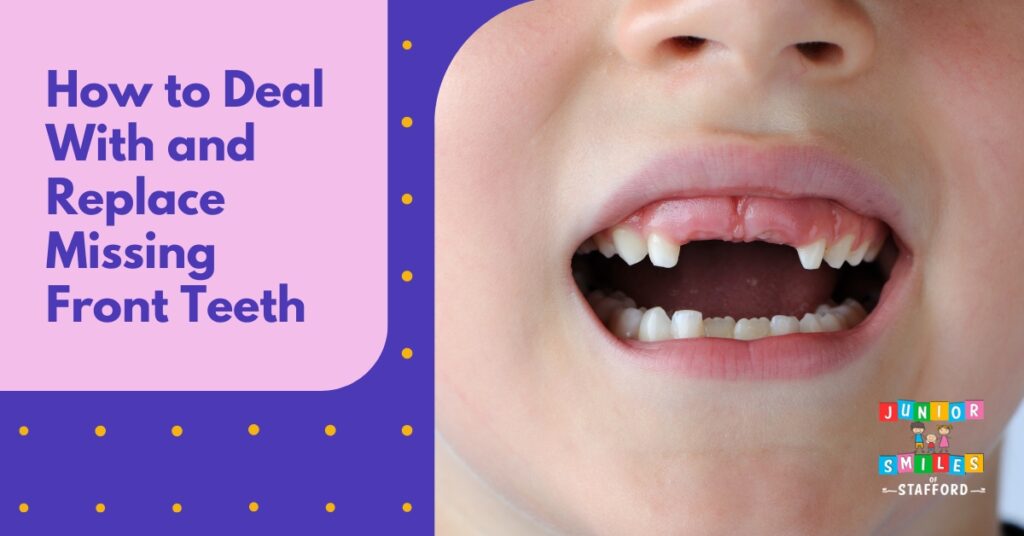Everything You Need to Know About Children’s Missing Front Teeth

Imagine how exciting it would be to see your child’s first tooth emerge and watch as the smile spread across their face. Imagine the same person a few years later, wearing his or her missing front teeth like a badge of honor and a significant life event. The loss of baby teeth is a big deal for everyone involved, from the kid getting a visit from the Tooth Fairy to the parents learning about the fascinating process of tooth development. However, how well do we grasp this procedure?
In this article, we’ll discuss the many causes and treatments for missing front teeth in kids. Whether you’re a worried parent, a loving grandparent, or just curious about this interesting developmental period, we’ll discuss the effects of tooth loss, what to do once teeth fall out, and what treatments are available.
Why Children Lose Their Front Teeth
It is a natural part of a child’s growth to lose their front teeth, sometimes known as their “baby” or “milk” teeth. Around six months of age, most children will begin to see the first of their twenty main teeth appear. Teeth like this help kids learn and develop important abilities like speaking and eating well in their formative years. However, these primary teeth aren’t intended to endure a lifetime. Here are the reasons why children lose their front teeth:
Natural Loss
Around the ages of 6 and 7, most children begin to lose their baby teeth and replace them with permanent adult teeth. This occurs as part of the maturation process and is completely normal. It’s normal for the roots of the adult teeth to begin squeezing the baby teeth as they get larger. Baby teeth fall out because the roots resorb, or disintegrate, under the constant stress of chewing. The milk or primary tooth, often known as the baby tooth, loosens and falls out over time to make place for the permanent tooth.
Accidents or Trauma
Children frequently participate in energetic play, which can occasionally lead to accidents occurring. Experiencing a fall, bump, or accidental impact can potentially lead to the loosening or premature loss of a tooth.
Tooth Decay
Most kids enjoy sugary treats. Even while baby teeth are meant to fall out eventually, they might still have cavities if proper care isn’t taken of them. A tooth can become so fragile from decay that it either falls out on its own or needs to be pulled.
The Impact of Missing Front Teeth
Although a grin with noticeable gaps might be charming in kids, there are other potential consequences to consider. Some of the instances are as follows:
Impaired Speech Development
The front teeth, in particular, play an important role in language acquisition. They help in pronunciation by directing the airflow and guiding the tongue to the correct positions for various phonetics. This might cause youngsters to temporarily lisp or have other speech changes when their front teeth fall out. But the good thing is that the discomfort associated with this is generally temporary and goes away as the permanent teeth come in.
Disrupted Eating and Nutrition
When a youngster is missing their front teeth, they may have trouble biting into meals, especially ones that are firm and crunchy, like apples and carrots. Therefore, as parents, you may have to change their diet for a period, choosing meals that are easier to chew or chopping them into smaller pieces.
Considerations for Orthodontics
The alignment and spacing of the developing permanent teeth can be affected by tooth loss and tooth development. Overcrowding and misalignment are two orthodontic problems that can result from either early or late loss and necessitate orthodontic treatment.
Immediate Steps to Take After Your Child Loses Their Front Teeth
The loss of teeth can be confusing for kids, and they may not comprehend right away. For this reason, it is the responsibility of parents to ensure their children are safe and cared for. Here are the steps you should take as soon as their tooth fell out:
Stay Calm
Experiencing tooth loss may provoke an initial response of alarm, particularly when accompanied by bleeding. That’s why it’s important to remain calm in order to avoid causing any distress to your child. The shedding of primary teeth, commonly known as baby teeth, is an entirely natural and expected milestone in your child’s growth and development.
Reassure Your Child
Reassure your child that their worries are natural and to be expected at this stage in their development. Reassure them that a replacement tooth will soon be in place. A conversation of encouragement and the promise of a visit from the Tooth Fairy may convert a frightening experience into one to be celebrated.
Clean the Mouth
it is advisable to instruct your child to delicately cleanse the affected area using a clean, damp cloth or alternatively, rinse their mouth with water. In the event that bleeding continues, it is recommended to gently apply pressure using a piece of gauze or a clean cloth for a brief period, or until the bleeding ceases.
Take Care of the Pain
In children, tooth loss can be distressing when caused by inflammation. An over-the-counter pain treatment that is appropriate for your child’s age may help ease his or her suffering. To ensure safe use, always refer to the labeled recommended dose.
Maintain Oral Hygiene
If your child has lost a tooth, you should still have them practice good dental hygiene, but pay special attention to the affected area. They should floss and clean their teeth twice a day, but not over the sensitive area until it has healed.
Visit Your Dentist
Consult your pediatric dentist in Stafford, VA as soon as possible if the tooth was knocked out in an accident, or if there are complications, such as ongoing discomfort, swelling, or other symptoms of infection. Even in cases of tooth loss due to natural causes, maintaining regular dental checkups is essential for ensuring the proper eruption of replacement teeth.
Treatment Options for Children with Missing Front Teeth
Observation and Monitoring
If the primary (baby) tooth is lost prematurely, sometimes it’s best to just wait and allow the permanent tooth to erupt, especially if the timing is close. The dentist will monitor the space and other teeth to ensure no significant shifting occurs.
Space Maintainers
These are appliances used to hold space open for the permanent tooth if a primary tooth is lost too early. They prevent adjacent teeth from drifting into the gap, ensuring there’s room for the permanent tooth to erupt.
Dental Flippers
A dental flipper is a removable partial denture, often made of acrylic, that can replace one or more missing teeth temporarily. It’s a common short-term solution, especially if the child is waiting for a more permanent solution in the future.
Dental Implants
While dental implants are a more permanent solution for missing teeth, they’re typically not recommended until the jaw has finished growing, which is usually in the late teens or early twenties. Early placement can interfere with jaw growth and the natural eruption of other teeth.
Pediatric Partial Dentures
Custom-made to fit the child’s mouth, these are removable appliances that replace missing teeth. They can be especially useful if multiple teeth are missing.
Bonded Bridges
This is a more permanent solution than flippers or dentures. A bridge uses adjacent teeth as anchors with a prosthetic tooth (or teeth) suspended between them to fill the gap. However, extra consideration is needed, as placing bridges in growing children might require revisions as they age.
Orthodontic Intervention
In cases where teeth are missing congenitally (from birth) and there’s no adult tooth to replace a lost primary tooth, orthodontic treatment can be used to move other teeth to fill the gap or to prepare the space for future restorative treatments.
Composite Resin Build-up
For cases where a tooth may be present but is undersized or misshaped, a dentist can use composite resin (tooth-colored material) to build up the tooth and make it appear natural.
It’s essential to consult with a pediatric dentist or orthodontist to determine the best treatment option based on the child’s specific needs, age, and the cause of the missing teeth. Each case is unique, and the best approach considers both the functional and aesthetic needs of the child.
Read more: Teething Rashes: Symptoms and Treatments
The Path Forward for Your Child’s Smile
Addressing missing front teeth in children is crucial, not just for aesthetics but also for ensuring proper oral function and development. At Junior Smiles of Stafford, we’re committed to providing comprehensive care tailored to your child’s unique needs. Whether it’s through observation, space maintainers, or more advanced solutions, our team is here to guide and support you every step of the way. Remember, each child’s dental journey is unique, and timely intervention can make all the difference. If your child has missing teeth or other dental concerns, don’t wait. Book a consultation with our pediatric dentists today and let’s chart the best path forward for a bright, confident smile.

